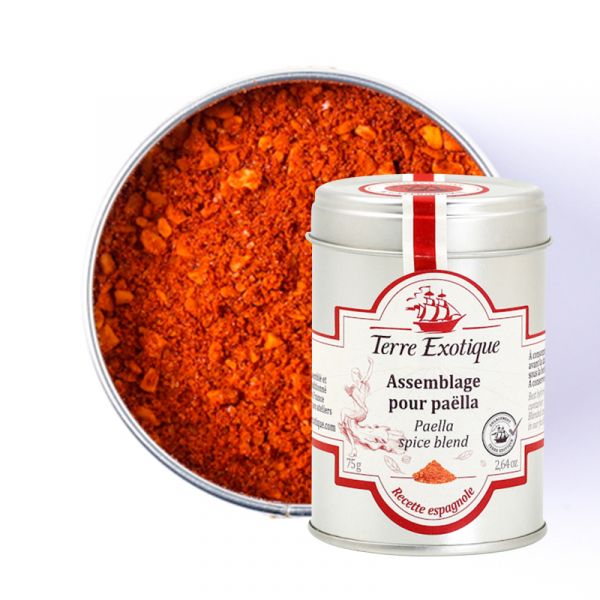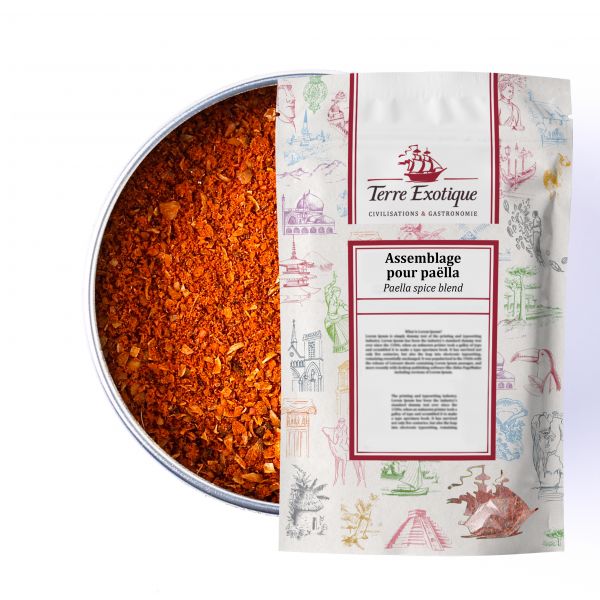





What dishes can the paella seasoning blend be used in?
Explore the spicy flavors of this blend
Our paella seasoning blend was developed with a friend from Valencia. While preparing paella is an institution there, we worked together to make its preparation easy and to bring out the flavors of paella in the seasoning blend. A tasty, easy, and quick trick: add a teaspoon to Basmati rice to give it Iberian flavors!How to use the paella seasoning blend?
Our recipe ideas for using the paella seasoning blend in your kitchen:- the real Valencian paella: once your tomatoes are fried, add 2 tablespoons of paella seasoning blend and then sprinkle with water;
- Spanish rice: add 1 teaspoon of paella seasoning blend to your rice after cooking;
- tortilla: once your eggs are beaten, add 2 teaspoons of paella seasoning blend;
- Iberian-flavored risotto: add 2 teaspoons of paella seasoning blend to your rice before covering with water;
- roasted chicken: sprinkle your chicken with 2 tablespoons of paella seasoning blend before roasting it in the oven with a drizzle of olive oil;
- paella-style broth: sprinkle 2 teaspoons of paella seasoning blend into your broth preparation.
Terre Exotique recipes with the paella seasoning blend
Find the recipe for Chicken and Rabbit PaellaThe aromas of the paella seasoning blend
The smoky and warm scent of the paella seasoning blend gives way to flavors of saffron, garlic, and paprika, evoking Spanish paella for sure.
What is the paella seasoning blend made of?
This blend is made up of garlic, saffron, salt, and smoked paprika.Saffron, whose Persian name "zapharan" means "stigma," is a spice derived from the three stigmas, or pistils, contained within the Crocus sativus. Its harvesting requires a lot of patience and skill. During its flowering, which lasts only 2 or 3 weeks, the crocus is carefully harvested. This requires the gentle hands of women to grasp these ephemeral flowers. Then comes the phase of stripping, where the women carefully remove the pistils from the flowers, keeping the most aromatic part with a precise and ancestral gesture.
Smoked paprika or Pimentón de la Vera, comes from a bushy plant that grows up to a meter high, Capsicum annuum, whose fruits are delicately hung up to dry, and then smoked over oak wood for two weeks. Only 12 factories in the Vera region have this know-how.
Its chorizo taste and dark red color are part of the Spanish traditional repertoire and brighten up family and popular dishes such as paella or tortillas.
Garlic, whose botanical name is Allium sativum, comes from the Liliaceae family. This perennial plant consists of a bulb formed by cloves wrapped in membranes. Garlic can grow up to one meter high.
The history of paella
Paella is one of the symbolic dishes of Spanish cuisine. Traditionally, paella was prepared for Sunday lunch and served as the main dish after mass. It was served at every religious or family celebration. Today, it is a popular dish around the world and no longer requires grand occasions to be prepared.Paella originates from Valencia, and its history begins with the cultivation of rice in Spain. The region was one of the largest rice-growing areas in the country.
It is worth noting that the word "paella" comes from the Latin "patella", which means small dish.
| Allergen | Sulfites / Sulphites |
|---|---|
| Native country | FRANCE |
| Ingredients | salt, garlic (sulphites), pimenton (pimenton, sunflower oil (1%)), |
| saffron | |
| TRACES EVENTUELLES D'ALLERGÈNES | céleri, sésame, moutarde, fruits à coques. |
 Français
Français 